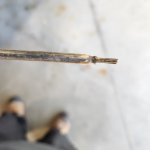Riverhart
Member
- Location
- Cedar Falls Iowa
- Occupation
- Traffic Signal Technician
I work in a small community maintaining the towns traffic signals and lighting. 3 years ago a concrete flood wall was built with decorative LED lamp posts on top of the wall. After 2 years we had a few lights fail. The wires between some of the lights had melted. I pulled in new wire and just assumed it was a nicked wire. Since then we have pulled new wire in between 6 sets of lights all with the same problem.
There is two 120v circuits, each on a 15 amp breaker. The circuits do not run together, so each conduit has 3 wires only. The wire is size #10 , RHW-2, rated at 90 degrees C. My total load on each circuit is roughly 7 amps. The conduit is 1"rigid encased in concrete in the flood wall. The conduit lengths are not abnormal for street lighting so voltage drop is minimal. The circuit breakers have never tripped. The contractor did not install grounding bushings to the rigid conduit, which I'm guessing is why the breaker never trips? All 3 wires are deformed, and kinked from the high heat. The hot will always be broke in half, and sometimes the neutral is also. The break always occurs exactly in the middle of the conduit run. When we pull the new wire in it is not a hard pull, and seems smooth, so I don't think the wire is getting compromised.
The only thing not done properly is the grounding bushings. Installing these now would be a huge project, because you cannot get your hand down the access hole. So we would have to rent a crane and lift the lights off to install them.
Any ideas what would be causing this?
There is two 120v circuits, each on a 15 amp breaker. The circuits do not run together, so each conduit has 3 wires only. The wire is size #10 , RHW-2, rated at 90 degrees C. My total load on each circuit is roughly 7 amps. The conduit is 1"rigid encased in concrete in the flood wall. The conduit lengths are not abnormal for street lighting so voltage drop is minimal. The circuit breakers have never tripped. The contractor did not install grounding bushings to the rigid conduit, which I'm guessing is why the breaker never trips? All 3 wires are deformed, and kinked from the high heat. The hot will always be broke in half, and sometimes the neutral is also. The break always occurs exactly in the middle of the conduit run. When we pull the new wire in it is not a hard pull, and seems smooth, so I don't think the wire is getting compromised.
The only thing not done properly is the grounding bushings. Installing these now would be a huge project, because you cannot get your hand down the access hole. So we would have to rent a crane and lift the lights off to install them.
Any ideas what would be causing this?



